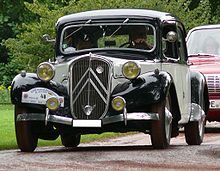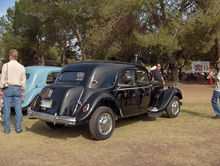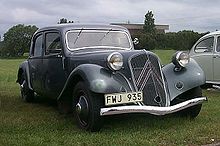- Citroën Traction Avant
-
Citroën Traction Avant 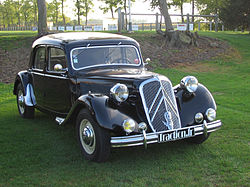
Manufacturer Citroën Also called Citroën 7CV
Citroën 11CV
Citroën 15CV
Citroën Light 15 (UK)
Citroën Big Fifteen (UK)
Citroën Big Six (UK)Production 7 CV 1934–1941
11CV 1934–1957
15CV 1938–1953Assembly Paris, France
Vorst, Belgium
Cologne, Germany
Slough, England
Copenhagen, DenmarkPredecessor Citroën Rosalie Successor Citroën DS Class Mid-size luxury car
Executive carBody style 4-door sedan
2-door coupé
2-door convertible
5-door hatchbackLayout MF layout Engine 1.3 / 1.5 / 1.6 / 1.9 L I4
2.9 L I6Transmission 3-speedmanual, column/dash shift Wheelbase 2,910 mm (115 in)
7CV & 11CV légère (light)[1]
3,090 mm (122 in)
11CV normale & 15-six[1]
3,270 mm (129 in)
11CV longue & 15-six limousine[1]Length 4,450 to 4,960 mm (175.2 to 195.3 in) Width 1,620 to 1,790 mm (63.8 to 70.5 in) Height 1,520 to 1,580 mm (59.8 to 62.2 in) Curb weight 1,025 to 1,170 kg (2,260 to 2,600 lb) Designer Flaminio Bertoni
André LefèbvreThe Citroën Traction Avant (French pronunciation: [tʁaksjɔ̃ aˈvɑ̃]) is an automobile which was produced by the French manufacturer Citroën from 1934 to 1957. About 760,000 units were produced.
Contents
Impact on the world
The Traction Avant, French for "front wheel drive", was designed by André Lefèbvre and Flaminio Bertoni in late 1933 / early 1934. While not the first production front wheel drive car – Alvis built the 1928 FWD in the UK, Cord produced the L29 from 1929 to 1932 in the United States and DKW the F1 in 1931 in Germany – it was the world's first front-wheel drive steel monocoque production car. Along with DKWs 1930s models, the Traction successfully pioneered front-wheel drive on the European mass car market.
The Traction Avant's structure was an arc-welded monocoque (unitized body). Most other cars of the era were based on a separate frame (chassis) onto which the non-structural body ("coachwork") was built. Monocoque construction (also called Unit Body or "Unibody" in the US today) results in a lighter vehicle, and is now used for virtually all car construction, although body-on-frame construction remains suitable for larger vehicles such as trucks.
This method of construction was viewed with great suspicion in many quarters, with doubts about its strength. A type of crash test was conceived, taking the form of driving the car off a cliff, to illustrate its great inherent resilience.[2]
The novel design made the car very low-slung relative to its contemporaries – the Traction Avant always possessed a unique look, which went from appearing rakish in 1934 to familiar and somewhat old fashioned by 1955.
The suspension was very advanced for the car's era. The front wheels were independently sprung, using a torsion bar and wishbone suspension arrangement,[3] where most contemporaries used live axle and cart-type leaf spring designs. The rear suspension was a simple steel beam axle and a Panhard rod, trailing arms and torsion bars attached to a 3-inch (76 mm) steel tube, which in turn was bolted to the "monocoque".
Since it was considerably lighter than "conventional" designs of the era, it was capable of 100 km/h (62 mph), and consumed gasoline / petrol only at the rate of 10 litres per 100 kilometres (28 mpg-imp; 24 mpg-US).
Variants
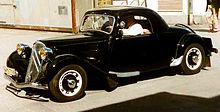 The 1937 7C Coupe Traction Avant
The 1937 7C Coupe Traction Avant
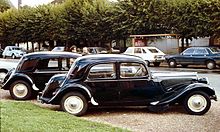 Traction Avant rears. The boot was lengthened and its volume doubled in Autumn 1952.[4]
Traction Avant rears. The boot was lengthened and its volume doubled in Autumn 1952.[4]
The original model, which was presented on 18 April 1934, was a small saloon with a 1,303 cc (79.5 cu in) engine. This model was called the 7A, which was succeeded in June 1934 by the 7B with a higher-power engine of 1,529 cc (93.3 cu in). The 7B in turn, was succeeded in October 1934 by the 7C with an even higher-output 1,628 cc (99.3 cu in) engine. Later models were the 11 (launched in November 1934), which had a 1,911 cc (116.6 cu in) four-cylinder engine, and the 15 (launched in 1938), with a 2,867 cc (175.0 cu in) six. The numbers refer to the French fiscal horsepower rating, or CV. The 11 was an 11 CV, but curiously the 15 was actually 16 CV. The 11 was built in two versions, the 11L ("légère", or "light"), which was the same size as the 7 CV, and the normal model 11, which had a longer wheelbase and wider track.
Citroën planned two variants that never entered production, since there was not enough funding available to develop them, except as running prototype vehicles. One was an automatic transmission-equipped model, based on the Sensaud de Lavaud automatic transmission, the other a 22 CV model with a 3.8 liter V8. The transmission (which was actually originally designed for the Citroen) was a "gearless" automatic, using the torque-converter alone to match engine revolutions to the drivetrain revolutions, much like the Dynaflow Transmission introduced later in the USA. The car was supposed to have a less spartan interior than the other Traction Avants and it was to feature Citroën's own new V8 engine. About twenty prototypes were made, but when the project was canceled in 1935 due to Michelin's takeover; they were probably all destroyed.[citation needed]
In addition to the 4-door body, the car was also produced as a 2-door coupé with a rumble seat, as a convertible and as an extended length Familial model with three rows of seats. There was even a hatchback-type Commerciale variant, in 1939, well ahead of its time, in which the tailgate was in two halves, the lower of which carried the spare wheel with the upper opening up to roof level. A one-piece top-hinged tailgate was introduced when the Commerciale resumed production in 1954 after being suspended during World War II.
Wartime disruption
In September 1939 France declared war on Germany and in June 1940 the German army rapidly invaded and occupied Northern France.[1] The war years were characterised by a desperate shortage of raw materials for civilian industry and of petrol,[1] but these factors were not apparent instantly. The Paris Motor Show scheduled for October 1939 was cancelled at short notice, but Citroën’s own planned announcements had involved the forthcoming 2CV model rather than any significant changes to the Traction.[1] For the Traction, the last “normal” year in terms of production levels was 1939, and 8,120 of the 2910mm wheelbase 1628cc engined 7C models were produced.[1] This tumbled to 1,133 in 1940, which was the first year when the plant suffered serious air-raid damage - on this occasion caused by a German attack - on 3 June 1940. Production of the cars was suspended in June 1941, by when a further 154 had been produced in the six month period just ended. The 7C would continue to appear in Citroën price-lists until March 1944, but production of this smaller engined “7CV” version of the Traction was not resumed after the war.[1] For the more powerful 1911cc engined 11 B-light models, the equivalent figures were 27,473 units produced in 1939, 4,415 in 1940 and 2,032 for 1941, though for this model production in 1941 ended only in November 1941 so the figure for that year represents 11 months of production.[1]
In 1945 production restarted only slowly: the 11 B-light reappeared very little changed from the 1941 cars except that headlight surrounds were now painted rather than finished in chrome. By the end of December 1945 the year’s production had reached 1,525.[1] Currency depreciation is evident from the car’s listed price which had been 26,800 francs in January 1940, and had risen to 110,670 francs in October 1945.[1] In 1945 the car was the only model available from Citroën, and as another sign of the times, customers not able to supply their own tires were charged an additional 9,455 francs for a set of five.[1] In May 1946, presumably reflecting an easing of the war-time tire shortage, the car could at last be purchased with tires at no extra cost, but by now the overall price of an 11 B-light had risen to 121,180 francs.[1]
The 11 B-normal model, differentiated from the 11 B-light by its 3090mm wheelbase, experienced a similar drop off in volumes between 1939 and 1941, with just 341 cars produced during the first seven months of 1941.[1] After the war, a single 11 B-normal was produced in 1946, in time to be presented at the October 1946 Paris Motor Show: production built up during 1947, but during the car’s ten year post-war period the shorter 11 B-light would, in France, continue to outsell the 11 B-normal.
Initially the French army lacked enthusiasm for the Citroën Traction, believing that it offered insufficient ground-clearance for their needs.[1] Nevertheless, by September 1939 roughly 250 had found their way into military service. With losses of cars at the frontier mounting, Citroën supplied a further 570 to the army between February and May 1940, and subsequent deliveries probably took place before military defeat intervened.[1] During the war many of the cars were reregistered with "WH..." (Wehrmacht Heer/Army command) license plates, having been requisitioned by the German Army.[1] These gave reliable service both in France and further afield, notably in Libya and Stalingrad. Tractions were also favoured by the Resistance, and as occupation gave way to Liberation they turned up all over France with FFI inscribed proudly on their doors. Less gloriously, the cars were known as favourites among gangsters such a the then infamous Pierrot le Fou, and his Traction gang.
UK built cars
Left-hand drive versions were built in Paris, in Forest, Belgium, in Copenhagen, Denmark for the Scandinavian market, and right-hand drive cars in Slough, England. The Slough version of the 11L was called the Light Fifteen and the long wheelbase 11 was called the Big Fifteen. This confusing terminology referred to the British fiscal tax rating of the time, which was higher than the French, so the 11CV engine was 15HP in England. The 15CV model was called "Big Six" in reference to its 6-cylinder engine. They were equipped with the leather seats and wooden dashboards popular in the UK, had a 12-volt electrical system and were distinguished by a different radiator grille and different bumpers. Some models also had a sliding sunroof.
A 1,911 cc (116.6 cu in) Light Fifteen tested by the British magazine The Motor in 1951 had a top speed of 72.6 mph (116.8 km/h) and could accelerate from 0–60 mph (97 km/h) in 29.7 seconds. A fuel consumption of 25.2 miles per imperial gallon (11.2 L/100 km; 21.0 mpg-US) was recorded. The test car cost GB£812 including taxes.[5]
A 2,866 cc (174.9 cu in) six-cylinder model was tested by the same magazine in 1954 and for this car the top speed found was 81.1 mph (130.5 km/h), acceleration from 0–60 mph (97 km/h) 21.2 seconds and fuel consumption 18.6 miles per imperial gallon (15.2 L/100 km; 15.5 mpg-US). The test car cost GB£1,349 including taxes.[6]
Engineering
The Traction Avant used a longitudinal, front-wheel drive layout, with the engine set well within the wheelbase, resulting in a very favourable weight distribution, aiding the car's advanced handling characteristics. The gearbox was placed at the front of the vehicle with the engine behind it and the differential between them, a layout shared with the later Renault 4 and first generation Renault 5 but the opposite way round to many longitudinal front-wheel drive cars, such as the Saab 96 and Renault 18 range and most Audi models. The gear change was set in the dashboard, with the lever protruding through a vertical, H-shaped gate[7]. Because this vertical orientation could have resulted in the car dropping out of gear when the lever was in the upper positions (i.e., second or reverse gears), the gear shift mechanism was locked when the mechanical clutch was engaged and released when the clutch pedal was depressed. The result of this layout, along with pendant pedals, umbrella-type handbrake control and front bench seats, was a very spacious interior, with a flat and unobstructed floor. The low-slung arrangement also eliminated the need for running boards to step into or out of the vehicle. These features made them ideal for use as limousines and taxi cabs, and they were quite popular among drivers and passengers alike. Until 1953, black was the only color choice[8].
Impact on Citroën
1954 six-cylinder 15CV with hydropneumatic suspension fitted to the rear wheels – in 'high' position
The development costs of the Traction Avant, combined with the redevelopment of its factory, were very high and Citroën declared bankruptcy in late 1934. The largest creditor was Michelin, who then owned Citroën from 1934 until 1976. Under Michelin, Citroën was run as a research laboratory, a test bed for their radial tires and new automotive technologies.
In 1954 Citroën's experiments with hydropneumatic technology produced its first result, the "15H" – a variant of the 6-cylinder model 15 with a self-leveling, height-adjustable rear suspension, a field trial for the revolutionary DS released the following year.
Directly after the introduction of the Citroën ID, a simplified and more competitively priced version of the still revolutionary DS, production of the Traction Avant ended in July 1957. Over 23 years, 759,111 had been built, including 26,400 assembled in Slough in England, 31,750 assembled in Forest near Brussels and 1,823 assembled at Cologne in Germany. The total reflects the production stoppage during World War II.
The Traction Avant today
In 2006, the oldest surviving 7A has production number ("coque nr") AZ 00-18, and is displayed in partly dismantled shape (engine and front wheels detached) in the Citroën Museum in Paris. The oldest running 7A is probably number AZ-00-23, which was, until 1 September 2006, in possession of a Dutch owner and is now with a Slovenian owner.
Traction Avants are fairly robust vehicles even by modern standards. Every few years, Traction Avant enthusiasts ship their vehicles to an exotic location for a rally. In 2002, for example, a group of over 30 Traction Avants drove from Los Angeles to New York without incident. [1]
References
- ^ a b c d e f g h i j k l m n o p q "Automobilia". Toutes les voitures françaises 1940 - 46 (les années sans salon) (Paris: Histoire & collections) Nr. 26: Page 21. 2003.
- ^ "The legacy of Andre Citroen". http://www.citroen.mb.ca/legacy/death&TA.html. Retrieved 2008-11-05.
- ^ "Torsion Bars Support Car Without Springs" Popular Mechanics, October 1934 drawings explaining suspension and body construction
- ^ "Automobilia". Toutes les voitures françaises 1953 (salon Paris oct 1952) (Paris: Histoire & collections) Nr. 14: Page 13. 2000.
- ^ "The Citroen Light Fifteen". The Motor. March 7, 1951.
- ^ "The Citroen Six". The Motor. March 24, 1954.
- ^ Willson, Quentin (1995). The Ultimate Classic Car Book. DK Publishing, Inc.. ISBN 0-7894-0159-2.
- ^ Willson, Quentin (1995). The Ultimate Classic Car Book. DK Publishing, Inc.. ISBN 0-7894-0159-2.
External links
- Citroën Traction Avant: Information, Service & Parts
- Citroen Traction Avant at Citroenet
- Traction Avant links Citroën World
- Traction Avant rentals in France
- CITROËN TRACTION AVANT
- Traction Avant district CitCity
- CITROENZ: Traction Avant modelcars
- Citroën Crash Test: Traction Avant 1934
Type 1950s 1960s 1970s 0 1 2 3 4 5 6 7 8 9 0 1 2 3 4 5 6 7 8 9 0 1 2 3 4 5 6 7 8 9 Economy car 2CV Off-roader Méhari Supermini LN / LNA Dyane Ami Visa Small family car GS Large family car 11 CV ID / DSpécial / DSuper Executive car 15 CV DS CX Grand tourer SM Citroën PSA Peugeot Citroën · Category · Vehicles
Current - Europe Current - China (DPCA) Historic Trucks Concept cars G Van · Prototype C · Prototype Y · 2CV Pop · GS Camargue · C44 · Karin · Zabrus · Activa · C6 Lignage · C-SportLounge · C-Airplay · C-Buggy · C-Airdream · GT by Citroën · Hypnos · DS Inside · Revolte · Survolt · C-CactusMotorsport Electric vehicle Categories:- Citroën vehicles
- Front wheel drive vehicles
- Coupes
- Sedans
- Hatchbacks
- 1930s automobiles
- 1940s automobiles
- 1950s automobiles
Wikimedia Foundation. 2010.



